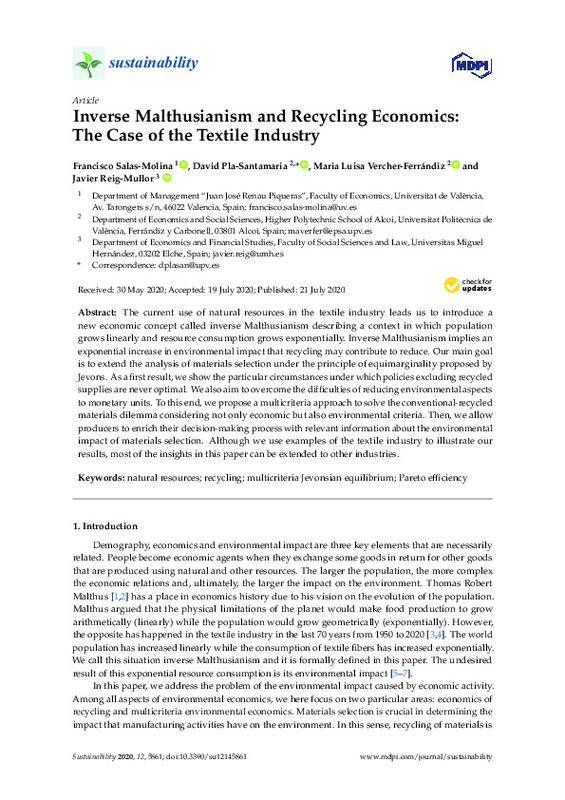Chapagain, A. K., Hoekstra, A. Y., Savenije, H. H. G., & Gautam, R. (2006). The water footprint of cotton consumption: An assessment of the impact of worldwide consumption of cotton products on the water resources in the cotton producing countries. Ecological Economics, 60(1), 186-203. doi:10.1016/j.ecolecon.2005.11.027
Esteve-Turrillas, F. A., & de la Guardia, M. (2017). Environmental impact of Recover cotton in textile industry. Resources, Conservation and Recycling, 116, 107-115. doi:10.1016/j.resconrec.2016.09.034
McInerney, J. (1976). THE SIMPLE ANALYTICS OF NATURAL RESOURCE ECONOMICS. Journal of Agricultural Economics, 27(1), 31-52. doi:10.1111/j.1477-9552.1976.tb00964.x
[+]
Chapagain, A. K., Hoekstra, A. Y., Savenije, H. H. G., & Gautam, R. (2006). The water footprint of cotton consumption: An assessment of the impact of worldwide consumption of cotton products on the water resources in the cotton producing countries. Ecological Economics, 60(1), 186-203. doi:10.1016/j.ecolecon.2005.11.027
Esteve-Turrillas, F. A., & de la Guardia, M. (2017). Environmental impact of Recover cotton in textile industry. Resources, Conservation and Recycling, 116, 107-115. doi:10.1016/j.resconrec.2016.09.034
McInerney, J. (1976). THE SIMPLE ANALYTICS OF NATURAL RESOURCE ECONOMICS. Journal of Agricultural Economics, 27(1), 31-52. doi:10.1111/j.1477-9552.1976.tb00964.x
Romero, C. (2012). Short communication. Economics of natural resources: in search of a unified theoretical framework. Spanish Journal of Agricultural Research, 10(1), 29. doi:10.5424/sjar/2012101-329-11
Sandin, G., & Peters, G. M. (2018). Environmental impact of textile reuse and recycling – A review. Journal of Cleaner Production, 184, 353-365. doi:10.1016/j.jclepro.2018.02.266
Leal Filho, W., Ellams, D., Han, S., Tyler, D., Boiten, V. J., Paço, A., … Balogun, A.-L. (2019). A review of the socio-economic advantages of textile recycling. Journal of Cleaner Production, 218, 10-20. doi:10.1016/j.jclepro.2019.01.210
Hotelling, H. (1931). The Economics of Exhaustible Resources. Journal of Political Economy, 39(2), 137-175. doi:10.1086/254195
Solow, R. M. (1974). Intergenerational Equity and Exhaustible Resources. The Review of Economic Studies, 41, 29. doi:10.2307/2296370
Thampapillai, D. J. (1985). Trade-offs for conflicting social objectives in the extraction of finite energy resources. International Journal of Energy Research, 9(2), 179-192. doi:10.1002/er.4440090209
Stahel, W. R. (2016). The circular economy. Nature, 531(7595), 435-438. doi:10.1038/531435a
Geissdoerfer, M., Savaget, P., Bocken, N. M. P., & Hultink, E. J. (2017). The Circular Economy – A new sustainability paradigm? Journal of Cleaner Production, 143, 757-768. doi:10.1016/j.jclepro.2016.12.048
Ayres, R. U. (1997). Metals recycling: economic and environmental implications. Resources, Conservation and Recycling, 21(3), 145-173. doi:10.1016/s0921-3449(97)00033-5
Ljungberg, L. Y. (2007). Materials selection and design for development of sustainable products. Materials & Design, 28(2), 466-479. doi:10.1016/j.matdes.2005.09.006
Garcia-Bernabeu, A., Hilario-Caballero, A., Pla-Santamaria, D., & Salas-Molina, F. (2020). A Process Oriented MCDM Approach to Construct a Circular Economy Composite Index. Sustainability, 12(2), 618. doi:10.3390/su12020618
Scott, A. D. (1953). Notes on User Cost. The Economic Journal, 63(250), 368. doi:10.2307/2227129
Romero, C. (1997). Multicriteria decision analysis and environmental economics: An approximation. European Journal of Operational Research, 96(1), 81-89. doi:10.1016/s0377-2217(96)00118-x
Laitala, K., Klepp, I., & Henry, B. (2018). Does Use Matter? Comparison of Environmental Impacts of Clothing Based on Fiber Type. Sustainability, 10(7), 2524. doi:10.3390/su10072524
Materials Sustainability Indexhttps://msi.higg.org
Alcott, B. (2005). Jevons’ paradox. Ecological Economics, 54(1), 9-21. doi:10.1016/j.ecolecon.2005.03.020
Roy, J. (2000). The rebound effect: some empirical evidence from India. Energy Policy, 28(6-7), 433-438. doi:10.1016/s0301-4215(00)00027-6
Cambra‐Fierro, J., & Ruiz‐Benitez, R. (2009). Advantages of intermodal logistics platforms: insights from a Spanish platform. Supply Chain Management: An International Journal, 14(6), 418-421. doi:10.1108/13598540910995183
[-]









